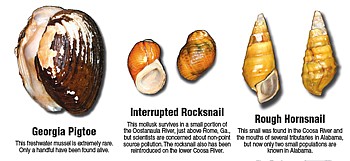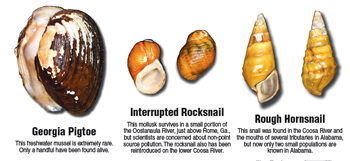The construction of dams in the early to mid-20th century is one of the main factors contributing to the Southeast's growing list of endangered species, a government biologist says.
The list's most recent additions are three species of mollusks once thought to be extinct.
"These are flowing-water species that require flows, and dams stop flows," said Paul Hartfield, endangered species biologist with the U.S. Fish and Wildlife Service in Alabama. "A lot of habitat has been destroyed, and we can't get it back. We're not going to get the dams out; no one is proposing to take the dams out."
But designating the species as endangered and portions of the Conasauga and Oostanaula rivers as critical habitat is a step in saving their populations, biologists say.
The three mollusks are the Georgia pigtoe mussel, the interrupted rocksnail and the rough hornsnail.
Georgia has 65 endangered species of plants and animals while Tennessee has 90 and Alabama has 107, records show.
The designation means "areas identified essential for the conservation of the endangered species may require special management considerations or protection, but [it] doesn't affect land ownership or establish a refuge or preserve and has no impact on private landowners taking actions on their land that don't require federal funding or permits," according to the Fish and Wildlife Service.
Whitfield County Commission Chairman Mike Babb said he doesn't think the new listing will affect greatly what the county does.
"I think mostly the way it's going to affect us is to continue, at present time, business as usual, to try to clean up the waters or keep them clean as they pass through our area," he said.
Having endangered species brings more attention to the area and regulations have to be met no matter what, Babb said.
Gradual die-offs or sudden mussel kills signal pollution problems in the environment on which mussels and humans both depend, according to the service. All three mollusk species have disappeared from 90 percent or more of their historical ranges.
NEW ADDITIONS* The Georgia pigtoe mussel is a freshwater mussel that filters water and is extremely rare. Only a handful have been found alive.* The interrupted rocksnail survives in a small portion of the Oostanaula River, just above Rome, Ga., but scientists are concerned about non-point source pollution. The rocksnail also has been reintroduced on the lower Coosa River.* The rough hornsnail was found in the Coosa River and the mouths of several tributaries in Alabama, but now only two small populations are known in Alabama.Source: U.S. Fish and Wildlife Service, endangered species list
About 160 miles of stream and river channels fall within the boundaries of the critical habitat designation in Bradley and Polk counties in Tennessee; Gordon, Floyd, Murray and Whitfield counties in Georgia; and Cherokee, Clay, Coosa, Elmore and Shelby counties in Alabama.
Officials with the Southeastern Power Administration, which markets electric power generated at reservoirs operated by the U.S. Army Corps of Engineers to customers in several states including Georgia, Alabama and Tennessee, declined comment on the new designation.
Southeastern Power Administration spokeswoman Melissa Sease said Monday the organization wouldn't comment on any potential impacts of the designation until it received official notification from the Fish and Wildlife Service or the U.S. Army Corps of Engineers.
A letter written last year to the Fish and Wildlife Service by Herbert R. Nadler, assistant administrator for power operations for Southeastern Power, states the organization "is very concerned about this issue and any potential change in river operations which might affect power generation and limit our ability to meet customer contractual requirements."
Hartfield said there already are other listed endangered species in the areas designated as critical habitat, and adding three more probably won't make a difference.
The most important change is awareness, he said.
"The Southeast has some of the highest aquatic diversity in the entire world," Hartfield said. "People need to recognize they can love these places to death."

